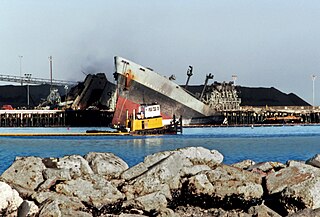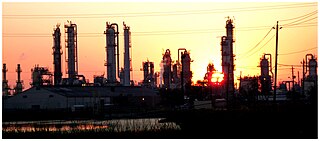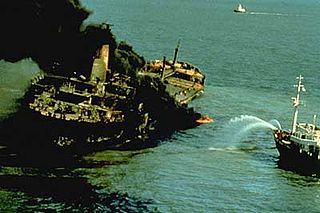Related Research Articles

The Economic Development Board (EDB) is a statutory board under the Ministry of Trade and Industry of the Government of Singapore that plans and executes strategies to sustain Singapore as a leading global hub for business and investment.

SS Sansinena was a Liberian oil tanker that exploded in Los Angeles harbor on Friday, 17 December 1976 at 7:33pm. She was docked at berth 46 at Port of Los Angeles in San Pedro, California.

ExxonMobil's Baytown Refinery is a major oil refinery named after and located in Baytown, Texas. It has capacity of 584,000 barrels per day (92,800 m3/d). The site first opened in 1919 and was originally operated by the Humble Oil Company. Today, it is the largest employer in the city. The plant takes up 2,400 acres (9.7 km2) of land next to the Houston Ship Channel.
The following lists events that happened during 1968 in Singapore.
The Whiddy Island disaster, also known as the Betelgeuse incident or Betelgeuse disaster, occurred on 8 January 1979, around 1:00 am, when the oil tanker Betelgeuse exploded in Bantry Bay, at the offshore jetty for the oil terminal at Whiddy Island, Ireland. The explosion was attributed to the failure of the ship's structure during an operation to discharge its cargo of oil. The tanker was owned by Total S.A., and the oil terminal was owned by Gulf Oil.
MT Independența ("Independence") was a large Romanian crude oil carrier. She collided in 1979 with a Greek freighter at the southern entrance of Bosphorus, Turkey, and exploded. She caught fire and grounded. Almost all of the tanker's crew members died. The wreck of the Independența burned for weeks, causing heavy air and sea pollution in the Istanbul area and the Sea of Marmara.

An oil tanker, also known as a petroleum tanker, is a ship designed for the bulk transport of oil or its products. There are two basic types of oil tankers: crude tankers and product tankers. Crude tankers move large quantities of unrefined crude oil from its point of extraction to refineries. Product tankers, generally much smaller, are designed to move refined products from refineries to points near consuming markets.

W. L. Steed was a steam tanker built in 1917–1918 by Bethlehem Shipbuilding Corporation of Quincy for Pan American Petroleum and Transport Company, with intention of transporting oil and petroleum products between Mexican and Gulf ports and the Northeast of the United States. The ship was briefly requisitioned by the US Government during World War I but returned to commercial service in early 1919. The ship was named after William L. Steed, superintendent of the Mexican Petroleum Company of California.
Esso Brussels was a commercial oil tanker built for the Esso Oil company in 1959. She was involved in a collision in 1973 in which thirteen of her crew perished. She was rebuilt and sailed under various other names until being scrapped in 1985.
Sea Witch was a MARAD Type C5-S-73b container ship built at the Bath Iron Works shipyard for American Export-Isbrandtsen Lines. She operated in the Atlantic trades for five years. So engaged on the evening of June 1, 1973, the vessel was involved in a disastrous collision with the oil tanker Esso Brussels in lower New York Harbor and was damaged so badly that she was removed from active service.

The M/T Burmah Agate was an oil tanker that was involved in a nautical collision and subsequent oil spill near Galveston, Texas in November 1979. 31 crewmen were killed in the collision, and the oil spill damaged the local environment.
The Venpet–Venoil collision was a maritime accident involving sister supertankers; the Liberian-registered Venoil and Venpet, in dense fog off the coast of South Africa on 16 December 1977. The tankers were travelling in opposite directions; the Venoil fully laden with over 250,000 tonnes of crude oil bound for Halifax, Canada, and the Venpet, travelling in ballast, headed for Kharg Island, Iran. The Venoil ploughed into the Venpet, eventually leading to the spilling of approximately 26,600–30,500 tonnes of crude oil. The tankers were sister ships owned and operated by Bethlehem Steel Corporation. Both ships were manned by Taiwanese crews.
The Okobie road tanker explosion occurred on 12 July 2012 when a tank truck in Okobie, Nigeria, fell into a ditch, spilled its petrol contents, and subsequently exploded, killing at least 121.
MV Dromus was a 1930s British oil tanker owned by Anglo-Saxon Petroleum, a British subsidiary of Royal Dutch Shell. She was launched in September 1938 by Harland and Wolff at Belfast in Northern Ireland. She was one of a class of 20 similar tankers built for Anglo-Saxon.
MV C.O. Stillman was an oil tanker that was built by a German shipyard in 1928 for a Canadian-based shipping company. A Panamanian subsidiary of Esso bought her at the end of 1936 and she was sunk by the German submarine U-68 in the Caribbean on June 4, 1942 about 41 nautical miles (76 km) southwest of Isla de Mona, Puerto Rico.

On 25 June 2017, a tanker truck exploded near Ahmedpur East in Pakistan's Bahawalpur District, killing 219 people and injuring at least 34 others. The truck overturned when its driver attempted to make a sharp turn on the N-5 National Highway. Once the news of the accident spread to nearby villages, hundreds of residents rushed to the scene to loot the truck of its cargo. The truck then exploded; early reports suggested the explosion was caused by someone lighting a cigarette.
Silverlip was a steam tanker built in 1902 by the W.G. Armstrong, Whitworth & Company of Walker for Sir Marcus Samuel owner and chairman of Shell Transport & Trading Company of London. The ship was designed and built to carry liquid cargo and spent her career carrying petroleum products from Borneo and Texas to United Kingdom and Europe.
India Arrow was a steam tanker built in 1921 by Bethlehem Shipbuilding Corporation of Quincy for Standard Oil Co., with intention of transporting oil and petroleum products between the United States and the Far East. During the first eight years the tanker was chiefly employed in the Pacific trade, carrying cargo between Gulf ports and a variety of destinations in East Asia. In late 1920s the tanker was moved to serve intercoastal trade routes while still making occasional trips to Asia. In early 1930s she was permanently assigned to trade routes between the Gulf and the ports on the United States East Coast, where she remained for the rest of her career.
MT New Diamond is a very large crude carrier. On 3 September 2020, the ship caught fire off the western coast of Sri Lanka, resulting in the death of a Filipino crew member. After burning intermittently for almost a week, the fire was reported to be extinguished by 11 September. In July 2021 the ship was beached at Gadani Ship Breaking Yard.
R. W. Gallagher was a steam turbine-powered tanker built in 1938 by Bethlehem Shipbuilding Corporation of Quincy for Standard Oil Company of New Jersey with intention of operating between the oil-producing ports of the southern United States and Mexico and the Northeast. The tanker spent her entire career in coastwise trade and was torpedoed and sunk on one of regular journeys in July 1942 by German submarine U-67.
References
- ↑ "48 die in ship blast horror". Singapore Press Holdings. Archived from the original on 12 January 2008. Retrieved 15 January 2008.
- ↑ "Hundreds join rush to give blood to injured". eresources.nlb.gov.sg. Retrieved 19 October 2021.
- ↑ Singapore, National Library Board. "The explosion and fire on board S.T. Spyros, 12th October 1978 : the inquiry report". eservice.nlb.gov.sg. Retrieved 1 October 2018.
- ↑ "Spyros accident | Infopedia". eresources.nlb.gov.sg. Retrieved 19 October 2021.